Email etiquette is the practice of using email in a clear, respectful, and professional way. It often shapes the first impression you leave on a colleague, client, subscriber, or employer.
When written well, email builds trust, improves engagement, and helps you reach your goals. But one poorly written or confusing message can lead to problems or damage your reputation.
At OptinMonster, we’ve seen firsthand how small email etiquette mistakes can snowball into bigger issues. We’ve seen businesses lose leads or miss out on conversions simply because they used confusing subject lines, sent emails at odd hours, or forgot to include proper calls to action. These kinds of small missteps often go unnoticed until the impact shows up in poor engagement, missed opportunities, or lower revenue.
This guide includes 27 rules for better emails so you don’t make the same mistakes. We’ve broken this guide into:
In this article, you will also find:
But first, let’s start with the definition of email etiquette.
What is Email Etiquette?
Email etiquette is simply about being thoughtful with how you write and send emails.
That means writing subject lines that say what the email is about, using a friendly greeting, not overloading the message, and replying in a reasonable amount of time. It’s also about being respectful, like not hitting “Reply All” when you don’t need to or sending a message at 11 p.m. just because you’re working late.
These habits help keep your communication clear, helpful, and well-received. It guides how to communicate in a way that’s respectful and effective, whether you’re reaching out to a colleague, a customer, or a mailing list.
And if you’re not sure where to start or what to change, the following 27 email etiquette rules offer practical, real-world guidance for writing better emails across different situations.
Basic Email Etiquette Everyone Should Follow

These basics apply to everyone, whether you’re a student, freelancer, or executive.
1. Use a clear, specific subject line
Your subject line sets the tone and expectations. Avoid vague phrases like “Quick Question” or “Follow-up.” Instead, aim for clarity and relevance. Example: “Q3 Budget Review Request – Action Needed by Friday.”
2. Greet recipients properly
Use the recipient’s name and an appropriate greeting. “Hi Alex,” works in most cases. Use “Dear” for more formal settings. Avoid skipping greetings altogether, especially in first-time communications.
3. Proofread thoroughly before hitting send
Typos and grammar mistakes hurt credibility. Always reread your message, especially names, links, and numbers. Tools like Grammarly can catch common errors quickly.
4. Keep it concise yet complete
Get to the point but don’t leave out context. One to two short paragraphs are usually enough. If more detail is needed, use bullet points or a numbered list.
5. Include a professional sign-off
End with a courteous and consistent closing. “Best regards,” “Thanks,” and “Sincerely” are safe choices. Avoid overly casual or quirky sign-offs unless you know the recipient well.
6. Respond within 24 hours
Timely replies show respect and reliability. If a full response will take longer, acknowledge the email and set expectations: “Thanks for your note. I’ll get back to you by tomorrow.”
7. Format for skimming
Use short paragraphs, headings, and bullet points to improve readability. Avoid large blocks of text. Make it easy for the reader to find key information quickly.
8. Avoid slang, emojis, or excessive punctuation
Keep language professional. “LOL,” smiley faces, and exclamation points can be misread or come off as unprofessional in formal exchanges.
9. Double-check names, links, and attachments
Getting a name wrong or forgetting an attachment undermines trust. Check everything before hitting send, especially when forwarding or replying to long threads.
10. Maintain a polite, neutral tone
Emails don’t convey tone well. Avoid sounding blunt or aggressive.
Rephrase demands as requests: “Can you send the file by 3 PM?” instead of “Send the file.”
11. Be mindful of timing
Avoid sending emails during weekends or after hours unless urgent. Schedule them for the next business day or use tools that send during working hours.
Email Etiquette & Rules for Businesses and Professionals
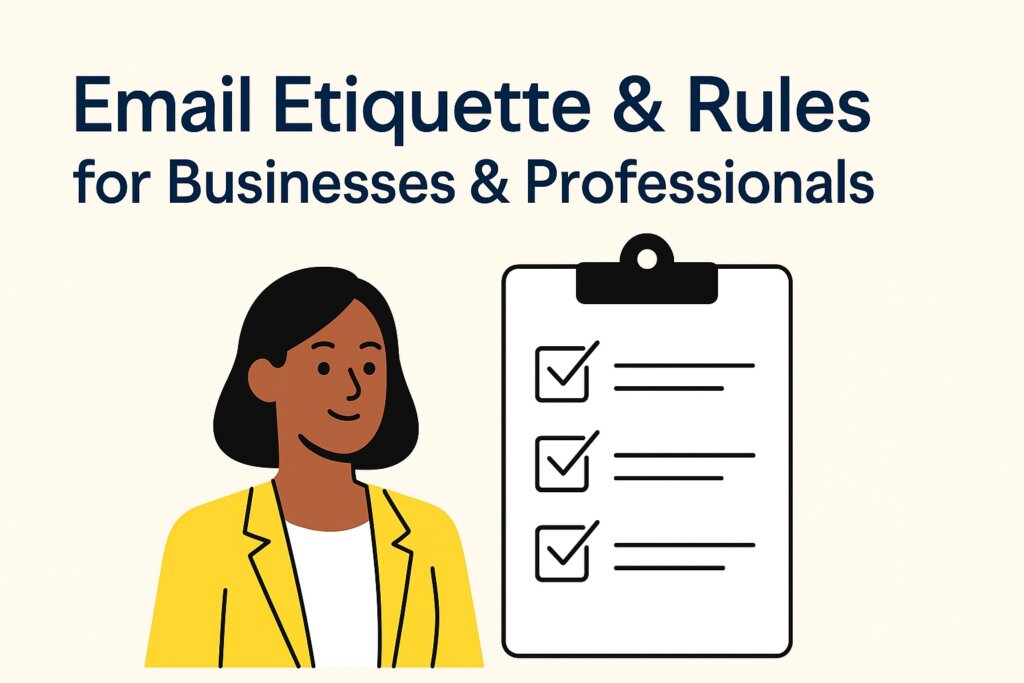
Professional email etiquette helps you write clearly and respectfully in workplace communication. Whether you’re emailing a client, coworker, or external partner, sticking to these basic rules will keep things clear and courteous.
12. Use a professional email address
Stick with your company domain or a version of your name. Avoid handles like “[email protected].” This matters especially for client and cold outreach.
13. Avoid unnecessary “Reply All” responses
Don’t clutter inboxes with irrelevant replies. Use “Reply All” only when every recipient needs the response. Otherwise, reply directly to the sender.
14. Use CC and BCC wisely
CC for transparency, BCC for privacy. Use BCC when sending to a large group to avoid exposing recipients’ email addresses.
Learn about CC and BCC and when to use what:
15. Provide context
Avoid assuming the recipient remembers past conversations. Summarize previous points or link to relevant threads or files.
16. State your ask or CTA clearly
Don’t make people guess. Be specific: “Please confirm your availability for the meeting by EOD Wednesday.”
17. Be direct but courteous
Get to the point, but remain respectful. Skip filler but keep a polite tone. Avoid passive-aggressive phrases like “per my last email.”
18. Avoid emailing in emotional moments
If you’re upset or frustrated, don’t email right away. Draft your message, take a break, and revisit it with a clear mind.
19. Use scheduling tools to respect business hours
Schedule emails to go out during working hours, especially if you’re working across time zones. Tools like Gmail’s send-later feature can help.
20. Adapt tone and formality to your audience and culture
Match your tone to the industry and relationship. A CEO might expect formality; a colleague on your team might prefer a relaxed tone. When in doubt, stay neutral.
Email Etiquette for Marketing Emails & Newsletters
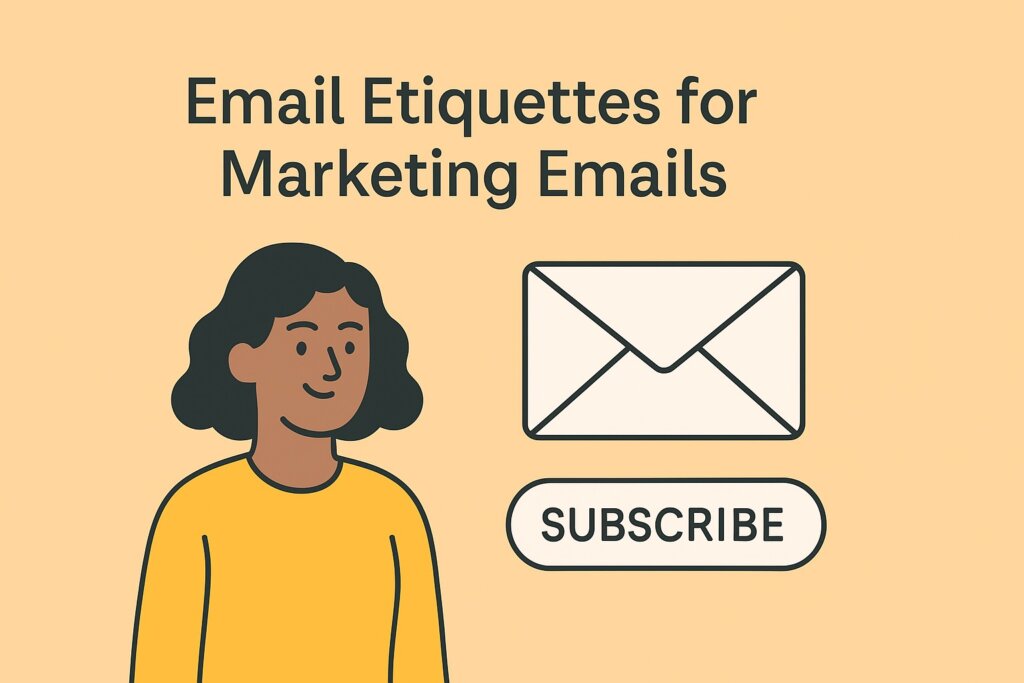
Marketing emails and email newsletters come with their own set of etiquette and legal responsibilities. Beyond writing clearly, marketers must ensure that every message respects the reader’s time, follows privacy regulations, and delivers value without being intrusive or misleading.
21. Use honest and relevant subject lines
No bait-and-switch. Make your subject line match the content inside. Misleading subject lines increase unsubscribe rates and hurt your reputation.
If you want to master email subject lines, check out the following resources. We’ve summarized our decade-plus email marketing experience in these articles:
- 121 Best Email Subject Lines And Why They Work! (2025)
- Top 40 Sales Email Subject Lines [2025]
- 15 Email Subject Line Best Practices (That Will Boost Your Open Rates)
- How Long Should Email Subject Lines Be?
22. Personalize your message
Use names, purchase history, or behavioral data when appropriate. Personalized emails often perform better and feel more genuine.
23. Lead with value, not a hard sell
Start by addressing the recipient’s needs or problems. Give helpful info or a quick win before pitching a product or service.
24. Write strong, specific CTAs
Instead of vague phrases like “Click here,” use specific actions such as “Download the guide,” “Book your demo,” or “Start your free trial.” Clear CTAs help readers know exactly what to expect and what step to take next. For example, “Get your free email checklist” is more effective than a generic link because it explains the benefit and outcome.
- 130+ Email CTA Examples That Can Boost Your Conversion Rate
- Call to Action Explained With 31 Inspiring Examples
- Which Is the Best Call to Action Button Color for Your Website?
25. Make your email skimmable and mobile-friendly
Many users read emails on phones. Use short paragraphs, clear headings, and large buttons. Test your email on mobile before sending.
26. Comply with email regulations
Always include a visible unsubscribe link and your company’s contact information. Follow CAN-SPAM and GDPR guidelines to stay legally compliant.
- Permission-based Email Marketing 101
- How to Create GDPR-Compliant Popups: Tips for Privacy and Trust
27. Test your emails before sending
Check all links, spelling, and formatting. Preview your email on different devices. Send a test to yourself to catch anything you might’ve missed.
Common Email Etiquette Mistakes to Avoid
- Using vague or clickbaity subject lines
- Writing emails that are too long or hard to scan
- Forgetting attachments or sending the wrong file
- Overusing emojis, jargon, or caps lock
- Sending messages with no clear CTA
- Using “no-reply” email addresses
- Failing to personalize or segment marketing emails
- Ignoring time zones or sending at odd hours
3 Tools That Can Help Improve Your Email Etiquette
Writing well takes effort, but a few smart tools can make the job easier. Whether you’re replying to a colleague or preparing an email campaign, these apps help you write with more confidence and less guesswork:
1. Grammarly
Helps you spot grammar and tone issues instantly. It scans your email for common writing mistakes, confusing sentences, and even tone mismatches. Ideal for catching issues before hitting send. You can explore Grammarly and add the Grammarly Browser Extension for faster checks.
2. Hemingway
Improves readability and clarity. It highlights long or complex sentences and suggests simpler alternatives. Great for business emails where skimmability matters. Try the Hemingway Editor to simplify your writing.
3. OptinMonster
Helps marketers grow their email list with smart, targeted lead capture campaigns. Here are a few ways it can support better email etiquette and help build trust and increase the number of replies you receive:
- Target the right audience: Use segmentation and behavior detection tools to send messages only to the most relevant subscribers, avoiding the mistake of broad, irrelevant emails. Learn more about page-level targeting.
- Time your messages: Schedule popups or campaigns based on time zones or exit intent, helping you respect your audience’s timing preferences.
- Use personalized lead magnets: Tailor offers based on page-level behavior or referral sources to make your emails more relevant and respectful of your audience’s needs. See how on-page behavior targeting works.
- Improve list quality: Use features like two-step opt-ins and lead verification to reduce fake or uninterested subscribers, helping ensure your emails are welcome and effective. Use MonsterLinks™ to convert any link, button, or image into a high-converting two-step opt-in form.
You can try OptinMonster risk-free here.
Each tool plays a role in helping you communicate more clearly, respectfully, and effectively, whether you’re refining your message or improving how and when it’s delivered.
Make Email Etiquette a Habit
How you use email reflects how you work. It shows your attention to detail, your tone, and your priorities. Whether you’re sending a quick update, reaching out to a new lead, or launching a campaign, these etiquette rules help you write with purpose.
Use them to cut through the noise, earn more replies, and show respect in every message you send.

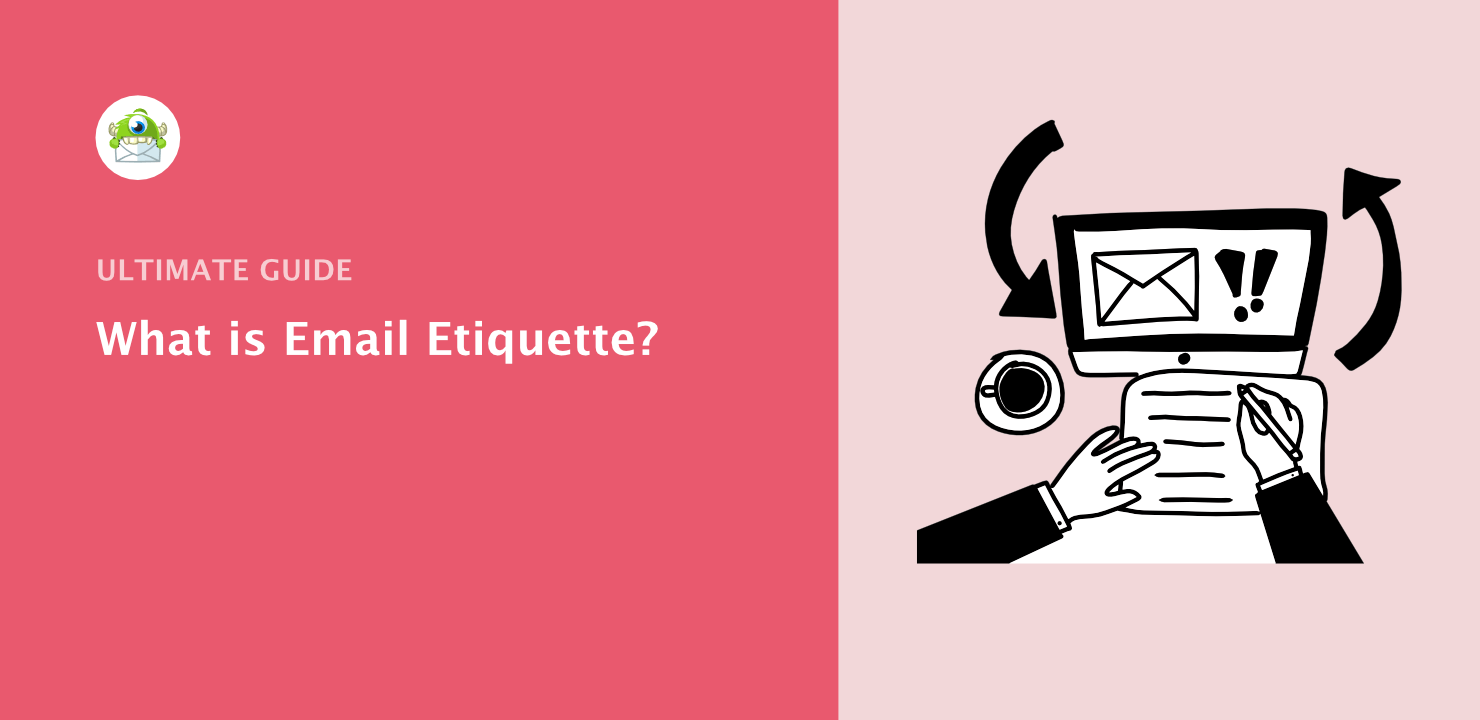
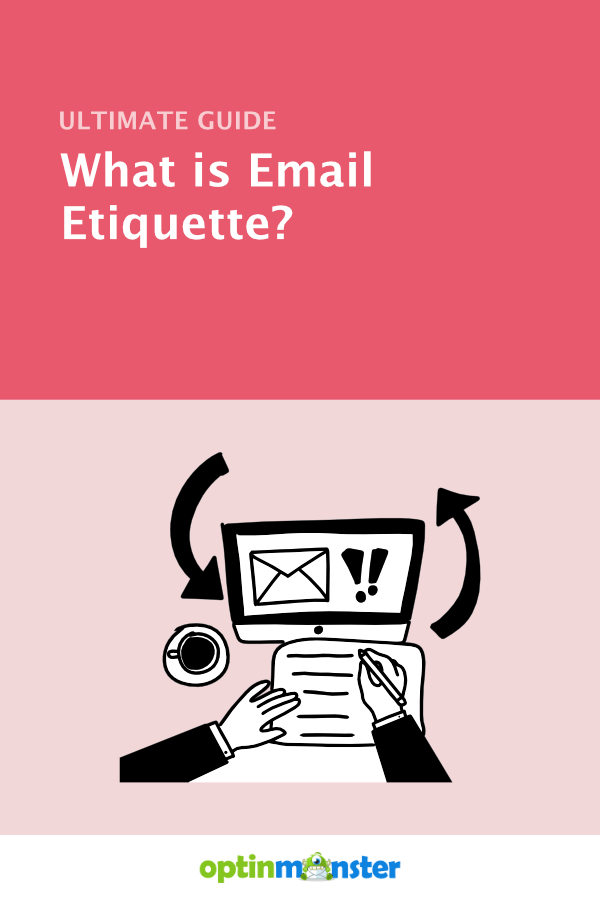




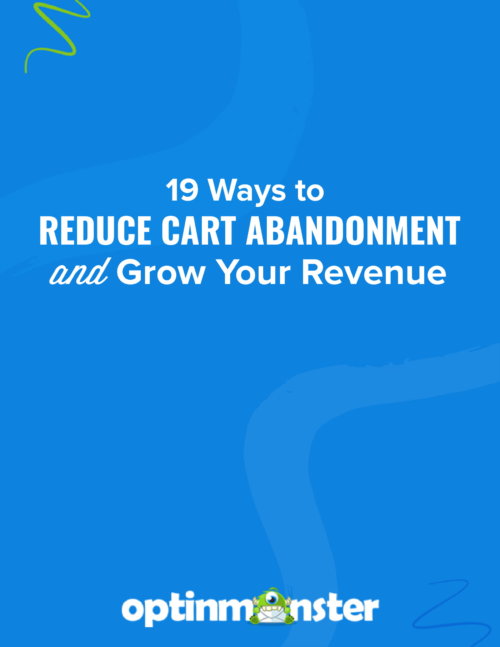



Add a Comment